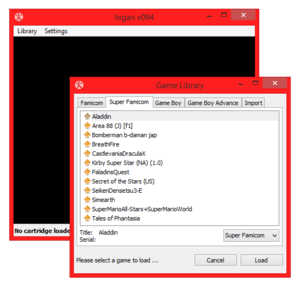Higan (emulator)
|
| |
|
Higan v094 running on Windows 8.1 | |
| Developer(s) | byuu et al. |
|---|---|
| Initial release | May 2005 |
| Stable release | 094 / January 20, 2014 |
| Development status | Dormant |
| Written in | C++11, C99 |
| Operating system | Windows, OS X, Linux, FreeBSD |
| Platform | IA-32, x86-64 |
| Size |
|
| Type | Video game console emulator |
| License | GNU GPLv3 |
| Website |
byuu |
Higan (stylized as "higan") is an emulator for multiple Nintendo video game consoles, including the Super Nintendo Entertainment System and NES. Originally called Bsnes (stylized as "bsnes"),[1] the emulator is notable for attempting to emulate the original hardware as accurately as possible through low-level, cycle-accurate emulation and for the associated historical preservation efforts of the Super NES platform.[2][3]
Overview
Development of Higan began by the programmer known as Byuu (stylized as "byuu") on October 14, 2004 as Bsnes, and the first version was released in May 2005 for Microsoft Windows. Since then, it has been ported to Linux, OS X and FreeBSD. Initially developed under a custom license, later releases were licensed under various versions of the GNU General Public License.
The Higan project has contributed significantly to the field of Super NES emulation, with a number of firsts in SNES emulation, and in reverse-engineering developments such as the organization of funds, hardware, and expertise for decapping the SNES's enhancement chips.[3]
Higan's developer claims its ability to run every commercial Super NES title ever released[4] Higan is the first emulator to have featured SPC7110 emulation, cycle-accurate SPC 700 emulation, cycle-accurate Super FX emulation, and Super Game Boy emulation.[5] Newer versions of Higan can experimentally emulate the NES, Game Boy, Game Boy Color, and Game Boy Advance. Forked versions of Bsnes have provided emulation support for Nintendo DS, XBAND, Super Famicom Box, Satellaview BS-X software, and tool-assisted speedruns.[6]
Reception
In 2008, British Internet magazine WebUser recommended Bsnes for "some fun old-school gaming".[7] In 2009, Japanese game magazine GameLabo recommended Bsnes for "those seeking a realistic playing experience".[8]
See also
References
- ↑ new name - higan "byuu.org". Retrieved October 8, 2012.
- ↑ Byuu (August 9, 2011). "Accuracy takes power: one man’s 3GHz quest to build a perfect SNES emulator". Ars Technica. Retrieved March 11, 2015.
- ↑ 3.0 3.1 Fenlon, Wesley. "16-bit Time Capsule: SNES Emulator Makes a Case for Software Preservation". Retrieved March 11, 2015.
- ↑ Bannister, Richard (February 2006). Emulation Nation: Interview - Richard Bannister. Retro Gamer (21). Interview with Craig Grannell: 97.
- ↑ "The State of Emulation, Part III". byuu's homepage. Retrieved July 5, 2012.
- ↑ "tasvideos.org Preferred Emulators". tasvideos.org. Retrieved May 13, 2012.
Isnes
- ↑ "Downloaded". WebUser (191): 39. 2008.
- ↑ "SFC". GameLabo (September): ?. 2009.
External links
- Official website
- Official discussion forum
- Linux packages for various distributions
| ||||||||||||||||||||||||||||||||||||||||||||||||||||||||||||||
